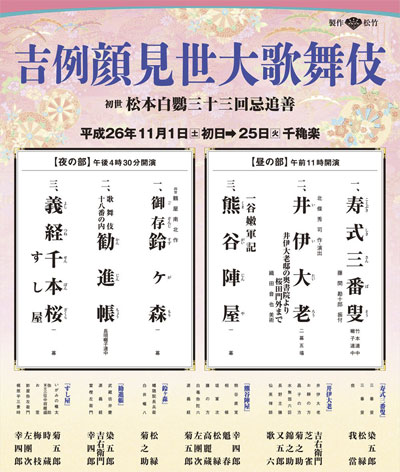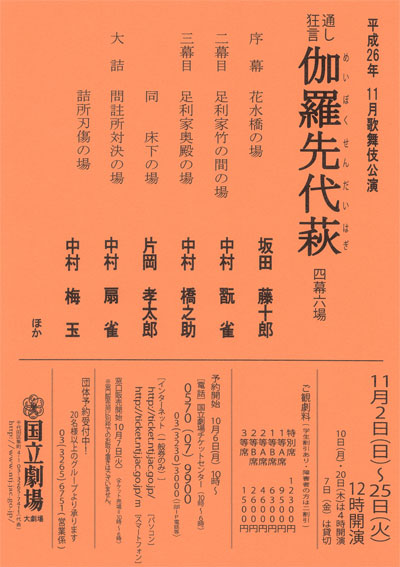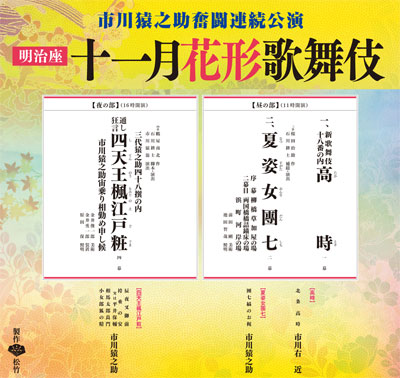| NOVEMBER 2014 |
|
6 shows in T˘ky˘ (Kabukiza, National Theatre, Meijiza, Nikkei Hall), 1 in Toyooka (Eirakukan), 1 in Yamaga (Yachiyoza), 1 in Ky˘to (Minamiza) and 1 tour (Sh˘chiku ďkabuki Tour)!
|
| Kabukiza (T˘ky˘) |  |
| Dates | 1 ~ 25 November 2014 (Kichirei Kaomise ďkabuki) Annual Festive Face-Showing Grand Kabuki |
| MatinÚe | |
| Evening | |
| Casting |
Living National Treasure Onoe Kikugor˘, Living National Treasure Nakamura Kichiemon, Matsumoto K˘shir˘, Nakamura Tokiz˘, Onoe Kikunosuke, Nakamura Shibajaku, Kataoka Gat˘, Nakamura Kinnosuke, Nakamura Kaishun, Ichikawa Somegor˘, Onoe Sh˘roku, Ichikawa Sadanji, Ichikawa Danz˘, Nakamura Matagor˘, Nakamura Karoku, Band˘ Hikosabur˘, ďtani Tomoemon, Ichimura Manjir˘, Ichikawa Unosuke, Kawarasaki Gonjűr˘, Ichikawa Komaz˘, Nakamura Baishi, Matsumoto Kingo, Sawamura S˘nosuke, ďtani Keiz˘, Nakamura Kamenoj˘, Band˘ Kametoshi, Nakamura Kash˘, Band˘ Minosuke, Nakamura Mantar˘, ďtani Hirotar˘, ďtani Hiromatsu, Nakamura Yonekichi, Nakamura Hayato, Nakamura Tanenosuke, Matsumoto Kintar˘ |
| Comments |
These programs commemorate the 32nd anniversary (33rd memorial service) of the passing away of Matsumoto Haku˘ I. His two sons, Matsumoto K˘shir˘ and Living National Treasure Nakamura Kichiemon, are the zagashira.
|
 |
| National Theatre (T˘ky˘) |
| Dates | 2 ~ 25 November 2014 |
| Program |
|
| Casting |
Living National Treasure Sakata T˘jűr˘, Nakamura Kanjaku, Nakamura Baigyoku, Nakamura Hashinosuke, Nakamura Senjaku, Kataoka Takatar˘, Band˘ Yajűr˘, Nakamura T˘z˘ |
| Comments |
T˘shi ky˘gen production at the National Theatre of "Meiboku Sendai Hagi" in 4 acts (6 scenes) with the classic structure; no rarely-staged is revived this month:
|
 |
| Meijiza (T˘ky˘) |  |
| Dates | 1 ~ 25 November 2014 (Jűichigatsu Hanagata Kabuki) Ichikawa Ennosuke Funt˘ Renzoku K˘en November Young Actors Kabuki Ichikawa Ennosuke's Continuous Struggle Performances |
| MatinÚe |
Natsu Sugata Onna Danshichi |
| Evening | |
| Casting |
Ichikawa Ennosuke, Kataoka Hidetar˘, Band˘ Takesabur˘, Ichikawa Monnosuke, Ichikawa Ukon, Ichikawa Emiya, Ichikawa Emisabur˘, Ichikawa En'ya, Ichikawa Shun'en, Band˘ Kamesabur˘, Ichikawa Juen, Ichikawa K˘tar˘, Onoe Ukon, Ichikawa Danko |
| Comments |
Second month of spectacular Kabuki performances in T˘ky˘ for the Omodakaya guild led by Ichikawa Ennosuke
|
 |
| Eirakukan (Toyooka) |  |
| Dates | 4 ~ 9 November 2014 (Eirakukan ďkabuki) |
| Program |
Katsuragawa Renri no Shigarami (Obiya) K˘ no Tori |
| Casting |
Kataoka Ainosuke, Kamimura Kichiya, Nakamura Kazutar˘, Kamimura Kichitar˘, Nakamura Jűjir˘, Kataoka T˘jűr˘, Kataoka Senjir˘ |
| Comments |
This is the 7th Kabuki program at the Eirakukan, a renovated traditional theater built in the city of Toyooka (prefecture of Hy˘go).
|
| Sh˘chiku ďkabuki Tour | |
| Dates | 12 ~ 25 November 2012 (Sh˘chiku ďkabuki) Sh˘chiku Grand Kabuki |
| Program |
Hikosan Gongen Chikai no Sukedachi
|
| Casting |
Kataoka Ainosuke, Kamimura Kichiya, Ichikawa Omez˘, Nakamura Kazutar˘ |
| Comments |
A special Autumn tour sponsored by the Sh˘chiku!
|
|
|||
| Dates | 29 October ~ 2 November 2014 Band˘ Tamasabur˘ Special Dance Performances |
||
| Program |
Kosunoto Aoi no Ue Kane-ga-Misaki |
||
| Casting |
Living National Treasure Band˘ Tamasabur˘ |
||
| Comments |
A special Buy˘ program starring the amazing Living National Treasure onnagata Band˘ Tamasabur˘ in Yamaga at the Yachiyoza, a traditional wooden-built theater. The 3 dances are traditional Jiutamai dances.
|
||
| Nikkei Hall (T˘ky˘) |
| Dates | 28 November 2014 (Kabuki Buy˘ K˘en) Kabuki Traditional Dances Performances |
| Program | |
| Casting |
Ichikawa Ennosuke, Ichikawa Monnosuke, Ichikawa En'ya, Ichikawa K˘tar˘ |
| Comments |
The 16th ďtemachiza stage performances at the Nikkei Hall in T˘ky˘.
|
|
|||
| Dates | 29 October ~ 2 November 2014 (JAPAN THEATER) | ||
| Program |
Heike Monogatari Otokodate Hana no Yoshiwara |
||
| Casting | |||
| Comments |
The first item of this program is a reading session of extracts from the "Heike Monogatari". The second item is the staging of the dance-drama "Otokodate Hana no Yoshiwara". |
||
|
|
| Contact | Main | Top | Updates | Actors | Plays | Playwrights | Programs | Links | FAQ | Glossary | Chronology | Illustrations | Prints | Characters | Derivatives | Theaters | Coming soon | News |